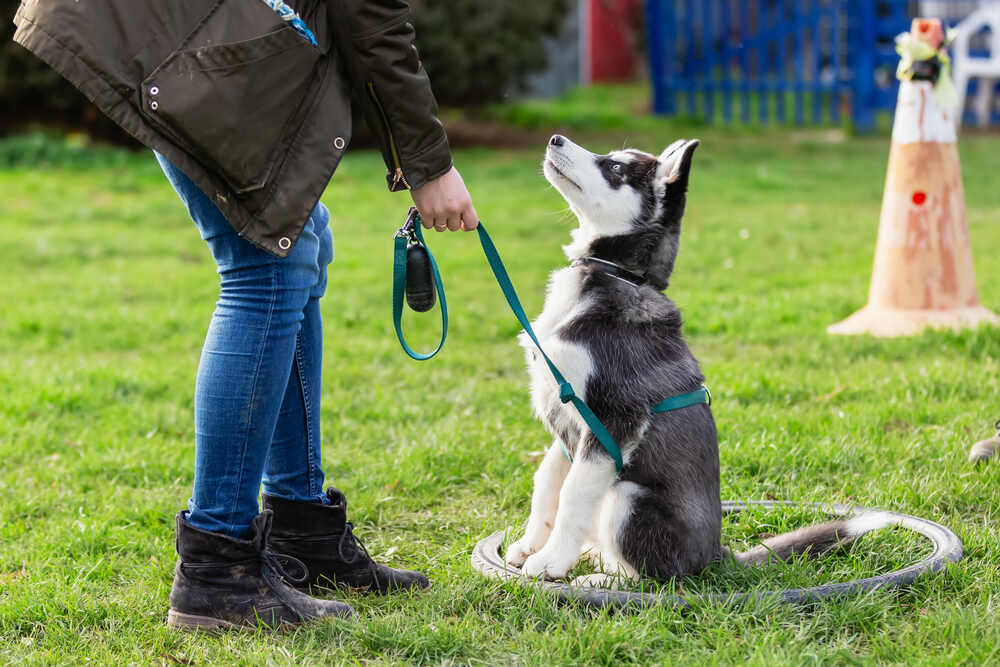Are you at the stage of learning to use a leash with your puppy? It is important to teach your puppy to walk on a leash from a young age.
Indeed, depending on its breed and adult weight, if walking is not well learned, your future walks may not be easy. Dog leash training is the subject of many myths, but we attempted to concentrate on the most prevalent ones. So, let’s learn myths about leash training.
Let’s break down some common myths about leash training and emphasize the importance of a positive, patient approach.
Leash Training Myths Debunked
- Myth 1: It’s Too Early to Start:
- Truth: Puppies can start learning basic leash skills very early. Positive experiences build a good foundation for walks as they grow.
- Myth 2: Positive Reinforcement Doesn’t Work:
- Truth: Treats and praise are powerful motivators! As your dog understands the behavior, rewards can become less frequent but still important.
- Myth 3: Puppies Shouldn’t Be Puppies:
- Truth: While training is important, puppies need patience! They’ll have good days and bad days – focus on making it fun.
- Myth 4: Leash Training is About Dominance:
- Truth: Modern training focuses on building communication and trust with your dog. Using force or intimidation backfires and damages your relationship.
- Myth 5: Dogs Hate Leashes:
- Truth: A dog properly introduced to the leash can view it as a signal that good things are about to happen (walks, playtime, etc.).
- Myth 6: Bad Behavior = Bad Owner:
- Truth: Dogs are individuals, just like people. Some learn faster, some have quirks. A responsible owner seeks guidance when they need it.
- Myth 7: Punishment = Effective Training:
- Truth: Yelling, hitting, etc., teach your dog to be afraid of YOU, not how to behave. It can worsen problem behaviors.
Key Takeaways
- Start Early, Be Patient: Leash training is a process, not an overnight fix. Young dogs learn quickly, but need time to build skills.
- Focus on the Positive: Make walks and leash time associated with fun, treats, and praise. Your dog will be more eager to learn!
- It’s About Communication: The leash isn’t just about control. As your dog learns to walk nicely, it becomes a way to signal what you both want.
- Seek Help When You Need It: Don’t struggle alone! Puppy classes and qualified trainers offer personalized guidance when you hit a roadblock.
Remember: A well-trained dog on a leash is a safe and happy companion. By focusing on building a positive relationship and using the right techniques, you help your dog enjoy walks as much as you do!
Myths About Leash Training:
Training and instilling “good manners” in a dog is another topic around which there are quite a few stereotypes. To make it easier for you to identify where the truth is and where the lies are, let’s get acquainted with the most popular of them.
It’s Too Soon To Begin Training Your Dog To Use A Leash:
Contrary to popular belief, it’s never too early to begin teaching your puppy. Your dog is a lifelong learner. Your dog is learning by everything he sees, smells, hears, tastes, or feels, and he will pick up new skills faster if something enjoyable occurs while he is learning.
Your dog will learn fast and enjoyably if you begin training him from the day you bring him home, set him up for success, and include enjoyable and rewarding activities in your everyday interactions.
Positive Reinforcement Doesn’t Work In Leash Training:
As soon as you stop giving your dog treats for following commands, he will stop obeying. Experts say that proper motivation is the main element of dog training! And it doesn’t have to involve giving the animal a “yummy treat.”
Positive reinforcement can include an affectionate gesture, a bath, or a walk in the park. Moreover, when your pet already understands the principle: follow the command – receive a reward, you can reduce the number of “bonuses”. Experience shows that in this case, dogs begin to try even harder, trying to earn approval.
Don’t Have Excessive Expectations for the Puppy:
Although it’s a good idea to do some basic training, keep in mind that puppies are still newborns and it may take them some time to successfully follow directions or regulate their behavior.
This also applies to adult dogs, who have a decompression phase as they adjust to their new living environment. Don’t count on training to run smoothly every day over the first few months!
When they bring a new puppy home and realize they’ve brought something horrible into the house, many people become a little nervous. There is no reason to be concerned as this is very natural.
That’s right, teach your puppy not yourself that toys are meant to be bitten! However, you shouldn’t be concerned that your puppy is a vicious creature that will attack you right away.
Leash Training Is To Dominate Your Dog:
To put it plainly, no. To succeed in training, you don’t need to “dominate” or “be alpha” towards your dog. Not your boss, but your dog wants to be your friend.
Training methods based on physical force and dominance ideology are not effective. They have been linked to an increase in hostility and are an ineffective method of training our pets.
Positive reinforcement training guarantees that your dog understands how to be a good pet and appreciates picking up new abilities!
Any Dog On A Leash Is Deeply Unhappy And Dreams Only Of Freedom:
The only time this statement is true is if an adult, untrained dog is put on a leash. Until she understands how to walk next to a person correctly, he will quite possibly become a burden to her.
As for dogs who have been familiar with a leash since childhood, the opportunity to frolic and run around with their owner in the park is quite enough for them. Of course, some breeds need more activity. It is advisable to let them run inside specially fenced areas.
A Dog’s Bad Behavior Is Solely The Fault Of Its Careless Owner:
This opinion is especially widespread among people who do not have animals. And everyone familiar with the process of their socialization and education first-hand knows that dogs, like people, are different. And it’s not easy to find the right approach for everyone.
Punishment Is Effective in Stopping Problem Behaviour:
There are no mystical treats that will teach your dog something or put an end to a behavior, and none of our pets are clairvoyant. Anything that can make a behavior less likely to occur is considered a punishment, and when dog trainers employ them, they are typically linked to aggression, fear, and avoidance.
It is not a good idea to yell, kick, or hit your dog in an attempt to teach it anything. It can appear that a dog will behave less aggressively around you if you punish it and make it fearful of you. However, that’s only because he’s become adept at avoiding you; he might still act in this manner without you.
Use sound to stop your dog’s undesirable behavior in its tracks rather than punishing them. Then, urge them to do something else to divert their attention.
Conclusion:
Puppies sometimes find their first contact with a leash unpleasant. Tied up, they cannot come and go freely or play wherever they please.
They may be disturbed or frightened by this object hanging above them, and if the leash is attached to a collar, the friction may be unpleasant for them.
Although the leash takes away some of the fun of being outside, as long as you get your puppy used to it properly, he will be happy to accept it. So, first of all, you must convince the puppy that the leash is a good thing and not something to be feared.
“Understanding the nuances of effective training techniques is essential for any learning process, be it for humans or animals. In the realm of pet care, Dog Training (Course) is particularly vital as it not only shapes obedient behavior but also fosters a bond between the pet and its owner. It offers an extensive course that is cost-effective, with the entire course priced at just the equivalent of what a dog trainer might charge for a single hour ($40 to $120). It covers a wide array of behaviours including Potty Training, Lunging, Jumping, Digging, Whining, Chewing, Excessive Barking, Impulse Control, Hyperactivity, Ignoring Commands, and much more. Plus, they provide a 100% money-back guarantee if you cancel within 60 days, ensuring that your investment is risk-free.”








